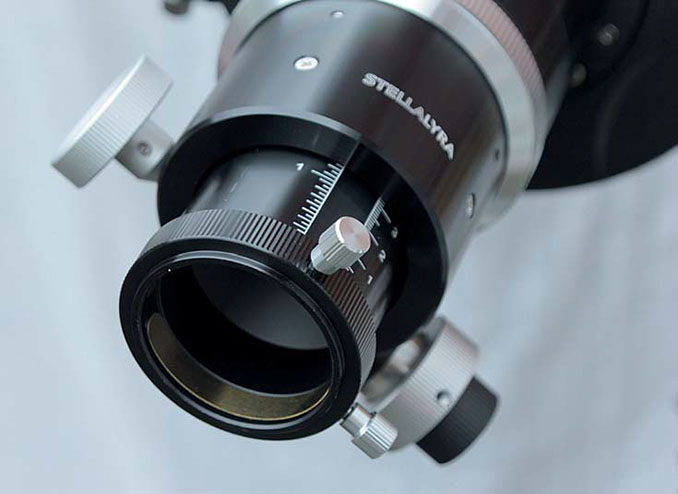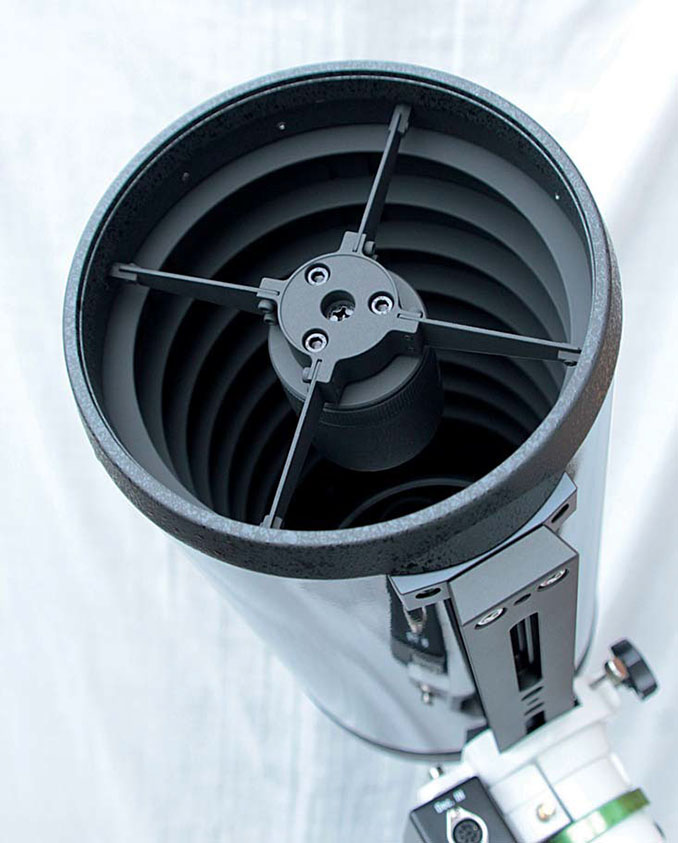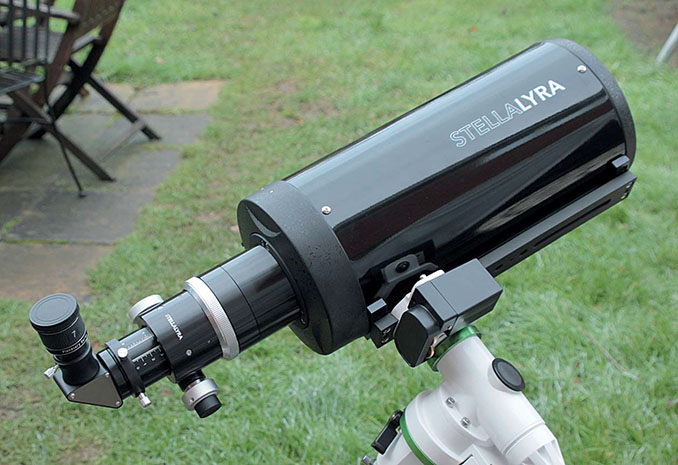
For those well-versed in optics, the name Cassegrain immediately evokes a mental image of a compact telescope, usually employing both lenses and mirrors to concertina a long-focal-length instrument into a short tube. The Schmidt– and Maksutov– Cassegrains mass-produced by Celestron and Meade have proved enormously popular for five decades, enabling users to possess large-aperture yet portable instruments of manageable weight. The pure or ‘classical’ Cassegrain telescope (hereafter referred to as the CC) is, though, a far older design and not so frequently encountered. Now Exeter-based First Light Optics is hoping to change all that with their newly released StellaLyra 153mm, f/12 M-CRF, reviewed here.

It’s all done with mirrors
First, a little history: who was Cassegrain and when did he invent his telescope? Laurent Cassegrain (c. 1629–93) was a French Catholic priest and academic whose eponymous optical design first appeared in the French science journal Recueil des mémoires et conférences concernant les arts et les sciences in April 1672. Cassegrain’s telescope produces an image from two specially curved mirrors, but a working prototype was never made in his lifetime because no optician of the period was capable of creating reflecting surfaces with the required shapes.
It took until the mid-1850s for optical testing methods to improve to the degree necessary for making the Cassegrain design viable. A Cassegrain telescope works like this: a concave primary mirror at the back of the tube gathers light from the subject and converges it towards the front where, just before it reaches focus, the light is intercepted by a small convex secondary mirror. The latter enlarges the image scale and reflects the light back down the telescope tube, passing through a hole in the primary’s centre, where it arrives at the rear of the telescope at an awaiting eyepiece or camera.
The CC requires a concave primary mirror with a complex paraboloidal shape formed by rotating a parabolic curve about its axis of symmetry – in this case, the optical axis. The convex secondary mirror needs to possess a hyperboloidal surface, which is produced when a hyperbola spins about its axis of symmetry.
A CC with a focal ratio of f/12, such as the StellaLyra model reviewed here, or longer, delivers excellent correction over moderate fields of view. Even in smaller apertures, it provides a large enough image scale to produce high magnifications with modest focal-length eyepieces, which are more comfortable to use.

First impressions
The StellaLyra 153mm, f/12 M-CRF arrives at your door in a single 66cm × 30cm × 33cm shipping box tipping the scales at 8.3 kilograms. The box bears the label ‘Made in Taiwan’, which is an excellent juncture to point out that the StellaLyra range is made for First Light Optics (FLO) by Guan Sheng Optical (GSO), a company well respected for the quality of its telescope mirrors and an innovator in this field. Once removed from all packaging, the telescope components have a combined mass of 5.88 kilograms, sans user- supplied star diagonal, eyepiece and finder.
Put in perspective, then, a bare-bones StellaLyra 153mm, f/12 M-CRF classical Cassegrain OTA has a similar weight to a 200mm, f/10 Schmidt–Cassegrain (SCT) optical tube. A 153mm Celestron C6 SCT tips the scales around 4.54 kilograms – one-and-a-third kilograms lighter for a direct aperture-for-aperture comparison. Therefore, the StellaLyra is well-matched to an EQ5-class mount, though I found a Sky-Watcher EQM-35 PRO (a beefed-up EQ3-PRO) was well up to the task for visual use, even at magnifications exceeding 250×.
The StellaLyra 153mm, f/12 M-CRF is undoubtedly a beautiful telescope to behold and exudes a definite air of quality. The hard anodised extension rings are so finely machined that they appear iridescent under certain lights. The optical tube is almost 44 centimetres long and 19.2 centimetres in diameter, with a slightly conical front-end ring and similarly profiled primary mirror cell of somewhat larger diameter. The rolled steel tube is finished in gloss black enamel, while the end castings have a satin black textured finish. All external bolts are of the Phillips head type, hopefully chromed/stainless for the UK’s maritime climate.
Surprisingly, the StellaLyra came without a manual of any sort, and there was no online link to one on the product’s webpage. I’m confident that FLO will rectify this oversight before the review goes to press, but if not, an Internet search will find you a manual of a rebranded version of an identical GSO instrument. Fortunately, the telescope is easy to get to grips with if one has previously owned or used any compound catadioptric, such as a Schmidt– or Maksutov– Cassegrain. However, unlike the latter, the StellaLyra CC doesn’t use a moving-primary-mirror method to focus – a fixed separation between the CC’s primary and secondary mirrors is essential to good performance.

Robust focusing
The StellaLyra 153mm, f/12 M-CRF employs a dual-speed Crayford focuser threaded onto the instrument’s visual back. If you think that the two-inch (50.8mm) thread of a typical SCT’s visual back is robust, then you’ll be impressed by the security and clear aperture afforded by the 88.9mm (3.5 inch) diameter thread on the rear of this instrument. The focuser attachment collar is captive and, like an SCT, you can rotate the focuser to a comfortable orientation before tightening it down with a twist of the knurled collar.
The back focus of the StellaLyra 153mm, f/12 M-CRF is a generous 157mm, so to achieve focus with a variety of viewing or imaging scenarios the instrument comes with three 88.9mm (3.5-inch) diameter threaded extension rings – one two-inch thick and two one-inch (25.4mm) thick. Each ring is beautifully machined and hard anodised with flat black milled interiors to prevent scattered light. In use, the rings thread onto the visual back before the focuser. For example, when using 1.25-inch (31.75mm) eyepieces in a 31.75mm star diagonal, I needed the two-inch plus a one-inch extension ring before the focuser. For a two-inch star diagonal, you may need just the two-inch extension ring, and so on.
Used visually with both the two-inch and a one-inch extension rings in place, and a 1.25-inch star diagonal, brings the working length of the StellaLyra 153mm, f/12 M-CRF to around 68cm. Despite possessing a Vixen-style dovetail rail 36cm long, the instrument is rather back-heavy with a balance point just 5cm in from the end of the rail. When using a heavy two-inch eyepiece, matching star diagonal plus a finder and bracket to fit the supplied Sky-Watcher-style shoe, you may need to add a small counterweight to the front of the dovetail rail. The latter has two milled channels and threaded mounting points for just this purpose.
The dual-speed Crayford focuser is a standard and widely used GSO model with a range of 35mm and a drawtube marked in both millimetres and sixteenths of an inch for repeatability of focus. The drawtube is two-inches, with a 1.25-inch adaptor; both use compression ring-style clamps so you won’t mar your eyepiece barrels. The stock focuser is certainly up to the task, but if you prefer something slightly more refined and robust, the Baader SteelTrack Diamond RT fits with Baader adaptor 2957283.

Superior light sealing
Looking in from the front of the telescope reveals eight strategically positioned knife-edge baffles, and a flat black interior finish for superior light sealing. This is evident from the minimal amount of scattered light perceptible at the eyepiece when looking close to the limb of a gibbous Moon (more on that later). Both the secondary and primary mirrors have cylindrical baffles of optimised length, further enhancing the instrument’s light-sealing credentials.
Collimation
Despite the StellaLyra’s trip from East Asia via Devon, the instrument arrived perfectly collimated – and I mean perfectly. I’m a stickler for precise alignment, and it’s rare for a telescope to pass through my hands without a tweak here and there. So it was a delight to use an instrument straight out of the box without any adjustments whatsoever, which should allay any fears that the StellaLyra might be somewhat delicate in the field.
When the StellaLyra 153mm, f/12 M-CRF eventually requires collimation, a Cheshire eyepiece is a wise investment if you don’t possess one already. The 50mm diameter secondary is centre marked, which is a huge help when trying to judge the optical components’ concentricity. The secondary mirror has three Allen head collimation bolts requiring a 4mm hex key, while on the rear of the telescope the primary mirror has three spring-loaded collimation bolts requiring a 3mm hex key, with 2.5mm Allen head grub screws to fix it in position once aligned.

Optical impressions
For anyone used to the sub-millimetre thickness of the cross-shaped secondary mirror spiders used on larger aperture Sky-Watcher reflectors, those found on the StellaLyra may seem overkill. The instrument’s four-vane secondary mirror support has ferrous metal arms almost 1.5mm thick, which undoubtedly gives the structure strength and stability. Still, I couldn’t help thinking that they would contribute a lot of diffraction noise. Hence it was high time that the StellaLyra 153mm, f/12 M-CRF gathered some photons so I could find out.
Fortunately for an instrument designed for high-power viewing, the StellaLyra Cassegrain’s test window coincided with a waxing gibbous Moon and better than average seeing conditions. On Thursday, 21 January, the eight-day-old Moon lay in Aries, and from 10.50pm GMT that night, my notebook tells of wonders beheld. The lunar sunrise terminator crossed the 100-kilometrewide crater Plato, on the northern edge of Mare Imbrium (‘Sea of Showers’), with high peaks around the crater rim just catching the rising Sun appearing as star-like points with attendant diffraction rings.


Further south, the 60-kilometre-wide crater Eratosthenes, at the end of the Montes Apenninus (Apennine Mountains), was also bisected by jet black, high-contrast shadows. As viewed with a 7mm Burgess/TMB Planetary Series eyepiece at 262×, I tracked north from Eratosthenes along the terminator. Marvelling at Mare Imbrium’s wrinkle ridges, which were thrown into stark relief by the shallow Sun angle, I moved past the 83-kilometre-wide terraced crater Archimedes and its environs, seen in jaw-dropping detail, towards the twin peaks of 2.4-kilometre-high Mons Pico and Pico β, both casting long shadows in the lunar early morning.
The Moon was arrestingly beautiful through the StellaLyra 153mm, f/12 M-CRF – so much so that it was hard to tear my eye away from it. I could have spent hours scrutinising innumerable craters, craterlets, wrinkle ridges, domes, mountain ranges and peaks revealed in exquisite high-contrast resolution down to the instrument’s resolution limit. Capella, the sixth brightest star in the night sky, showed a very delicate golden yellow hue to my eye and I was struck by the purity of star colours in the StellaLyra. One would expect this of a purely reflecting telescope with quality eyepieces, but this instrument is particularly good in this regard.
Aside from the star’s faithfully rendered hues, Capella sat at the centre of a cruciform diffraction pattern. The four spikes were no brighter or thicker than I had expected given the width of the spider vanes, but whether or not they bother you or, indeed, enhance the aesthetic, is a personal matter. They don’t affect the StellaLyra’s resolution, with Capella presenting a minuscule Airy disc with two and occasionally three diffraction rings in moments of better seeing.
Double stars are gorgeous in the StellaLyra. At 5.2 arcseconds, Castor is an easy split for this instrument, but to see generous dark space between the components is a novelty. The contrasting deep golden and bluish hues of Almach, or gamma Andromedae, further bore out the instrument’s colour fidelity.

Conclusions
The StellaLyra 153mm, f/12 M-CRF delivers everything expected of its aperture in wonderfully high-contrast views rendered in faithful hues. The primary and secondary mirrors are made of quartz, which has a low coefficient of thermal expansion. Hence you don’t experience long cool-down times like other telescopes, so you can be observing sooner. One can easily see why the cognoscenti rave about the classical Cassegrain design for lunar, planetary and double-star work. You could use a low-power two-inch eyepiece and a suitable star diagonal for fields of view up to a degree wide, but that’s not its forte: it’s an instrument designed for medium-to-higher-power viewing, in which it truly excels.
At a glance
Optical design: Classical Cassegrain
Aperture: 153mm
Focal length: 1,836mm
Focal ratio: f/12
Mirror substrate: quartz (SiO4)
Primary mirror: paraboloid, ≥95% reflectivity
Secondary mirror: hyperboloid, ≥95% reflectivity
Secondary mirror holder: 4-vane all-metal spider
Secondary mirror obstruction: 58mm
Tube outside diameter: 193mm
Tube length: 437mm
Focuser: 50.8mm (2-inch) dual-speed Crayford
Optical tube weight: 5.88kg
Price: £499
Details: firstlightoptics.com



